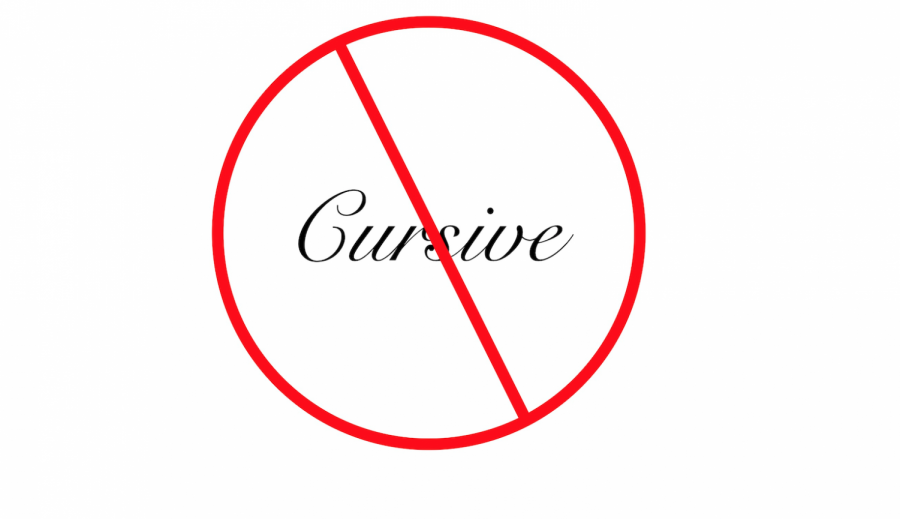Write cursive out of school curriculum
Staff Writer Owen Codere writes that teaching cursive is a waste of time.
March 6, 2019
While I believe there are many pointless skills that we learn in school every year, there has always been one that has haunted me the most. A subject that is forced upon nearly everyone and was claimed to be a practical way to improve and accelerate writing: cursive.
Cursive has been taught as far back as the 1700s with the purpose of conjoining letters while writing to improve flow and speed.
Personally, I learned cursive along with all of my classmates in the fourth grade, however, the grade in which it is taught varies from school to school. No matter when it’s taught, the majority of elementary schools require cursive to be taught.
The main reason why I find cursive to be such an impractical subject to be taught in elementary school is that it is just not used in life. I spent my whole fourth-grade year writing everything in cursive, and since then I have not used it in a practical way.
Sure, there are some exceptions; for instance, whenever I write my signature I use cursive. While most people also use cursive for their signature, I still do not believe this is a logical reason for it to be taught for a whole year. A cursive signature will not make a legal document more legal; it will just make the name appear more unique and fancy. A year of learning cursive at an elementary level is not necessary for someone to develop their personal signature.
Cursive originally was created for writing efficiently with a quill and ink to prevent smudges and broken tips. As surprising as it may seem, since arriving at Algonquin, I have yet to see someone using a quill and ink to write. In fact, the only time I have seen anyone using a quill and ink to write ever has been in a historical film or movie. Nonetheless, throughout the years, the tradition of this style of penmanship continued to be passed on even when technology advanced and ballpoint pens were invented. At the time, people still claimed it was a faster way of writing and thus speculated it would remain valuable in the future.
However, as revealed in the 2018 NPR article “So Longhand: Has Cursive Reached The End Of The Line?”, “cursive actually turns out to be slower than print, though the fastest style is a hybrid of the two.” A year is not needed for each student to develop their own hybrid style. At most a few weeks would be needed to introduce the new style, then the students should be encouraged to develop their own efficient way of writing quickly and neatly.
Another argument against removing cursive from school curricula is that it is a part of our history and that kids should be able to read documents such as the United States Constitution, which is written in cursive.
I disagree. I believe that teaching kids how to write cursive does not give them an advantage while trying to decipher the text of the Constitution. I spent over a year learning how to read and write cursive, yet the Constitution still looks as foreign as it did before. And when I did need to pass that history test, it was actually much easier to find typed versions of the Constitution than photographs of the original cursive document. Spoiler alert: the meaning of the words didn’t change when the fonts they were written in did.
As explained by Keith Wagstaff, a writer for “The Week” magazine, “An hour spent teaching cursive is an hour spent not teaching something that will actually be relevant to children’s lives.”
I believe that students should be taught something more valuable at such an early age that prepares them for growing up. Those who grow up and are still interested in cursive should be given the opportunity to learn it as an elective in high school or college, or even during an after-school enrichment program in elementary schools. Yet it should not be a topic that every student is forced to learn. Instead of struggling to make the perfect uppercase Q 50 times, those hours in elementary school would have been better spent on the substance, style, and ideas of writing– not what it physically looks like.











nobody owens • May 21, 2021 at 10:47 am
people still learn cursive in school? out of all of my siblings, none of us had more than a day or two of cursive instruction.
there’s no need to make it an elective (or even teach it in schools); it’s pretty straightforward to learn it on one’s own.
with the way tech dominates the world, students would be better off learning how to type in school, instead of learning a different (and increasingly irrelevant) method of handwriting.
Everybody Owens • Aug 21, 2022 at 6:42 pm
what
gaul • May 19, 2021 at 12:29 pm
Luckily, you do not have to be Nicholas Cage to read a PDF.
Noah C. Johnson • May 18, 2021 at 1:30 pm
cursive is, in no sense a skill that everyone needs, it should be available, but not mandatory; MAKE CURSIVE AN ELECTIVE; it is no more an essential skill then Latin; also there are several problems with the “historical documents argument” for it:
1. it is possible to know how to read something without being able able to write it yourself (for example I can read blackletter and gaelic script [which is not even typically used for writing English, though it can be used for that, outside of rare decorative inscriptions in Ireland, and a single house decoration my grandma owned], but I will never be able to write either of them myself); indeed many courses in dead languages like Latin focus on being able to understand what is already written in the language, not on being able to speak it or write it yourself
2. there are thousands of places you can find print versions of America’s founding documents, both hard copy and digital; some of the hard copies are from that era, those versions actually being what most people read, not the “originals”; and changing the font in which words are written does not change the meaning of them
3. the cursive versions of those documents are not in ‘modern’ (palmer style) cursive; but instead an older form known as “copperplate”, which is very different; also, the spelling is not the same as is typical today (for instance the words “chuse”, “Pensylvania”, “controul” and “defence” [that is how the document actually spells them]; among others); and they documents use the long s (an archaic form of a letter that cursive classes never mention even exists); add to that the fact that I have seen the originals of them for myself, and the writing is faded to the point of being barely legible; I could also add that the original version of the constitution capitalizes the first letters of common nouns, something that has vanished from English today, but should seem familiar if you have learned German as a foreign language like I have, but i think the point is clear even without that
4. reading the originals requires a trip to a specific room in Washington DC, which only a few people are able to do. and also, even if you can read cursive, you cannot read them in whole, as the displays they are on are permanently exposed to the first page only; so good luck with your impression of Nicholas Cage in the movie “National Treasure”; as that is the only way you will have the chance to read more than the 1st page of the originals; which you will be able to enjoy your new knowledge of them from prison, as stealing the original copies of the constitution or the declaration of independence is one of the most serious forms of theft from the US government possible, so expect to be on the FBI wanted list, for life, even if you somehow avoid jail
5. even if this is a skill that is taught, it is so niche that it should be AN ELECTIVE ONLY, some will choose to take it, some will not; if there are still historians, archeologists, and linguistics scholars who can read hieroglyphics, we can be sure a few will take that class
in short, cursive is both not needed, and not enough to read those documents in the original; and should be consigned to an elective like Latin. there is a distinction between skills vital enough that everyone should have them, and those that a few specialists need (and can learn without forcing the rest of us to spend hours learning it)